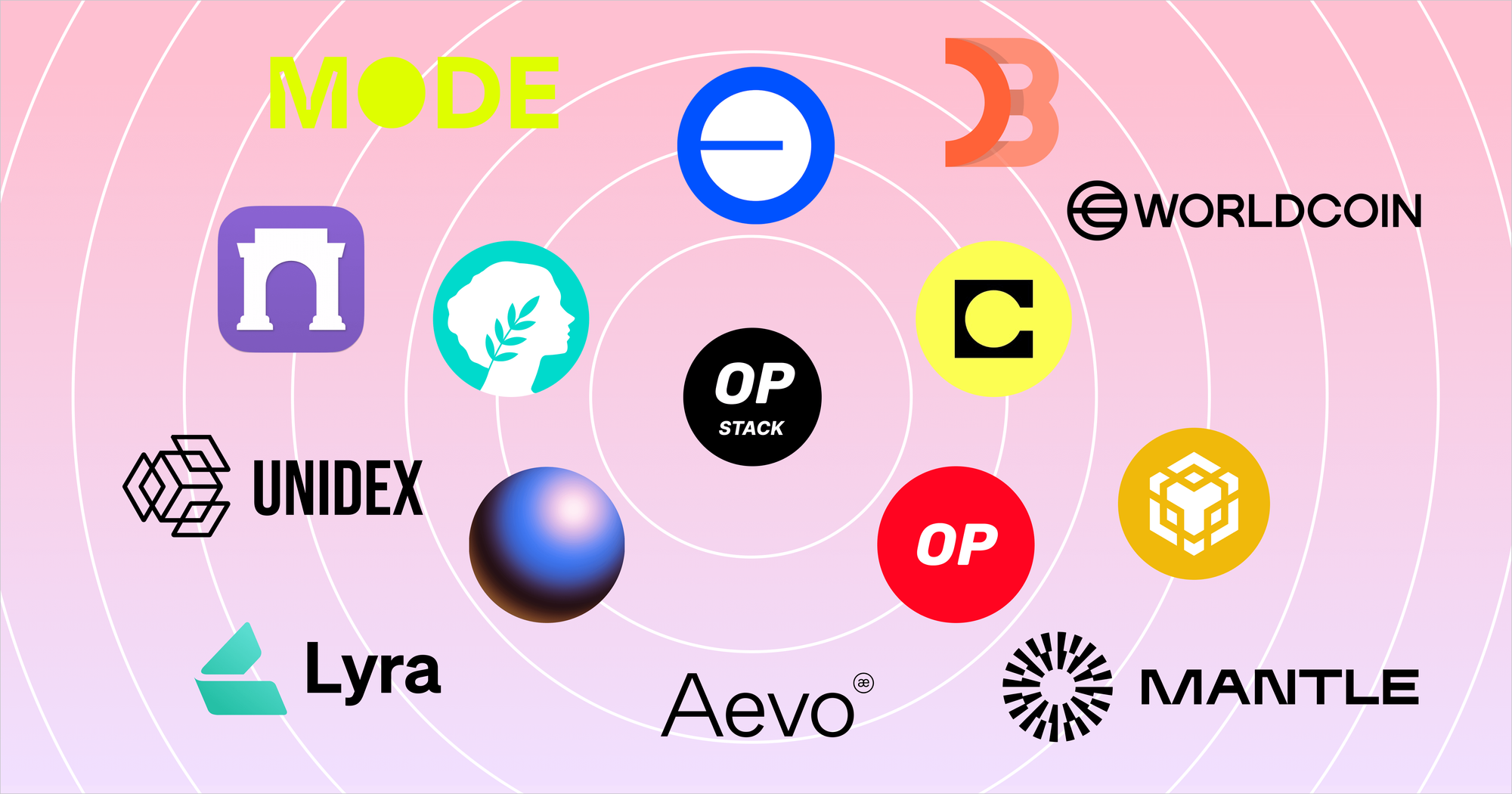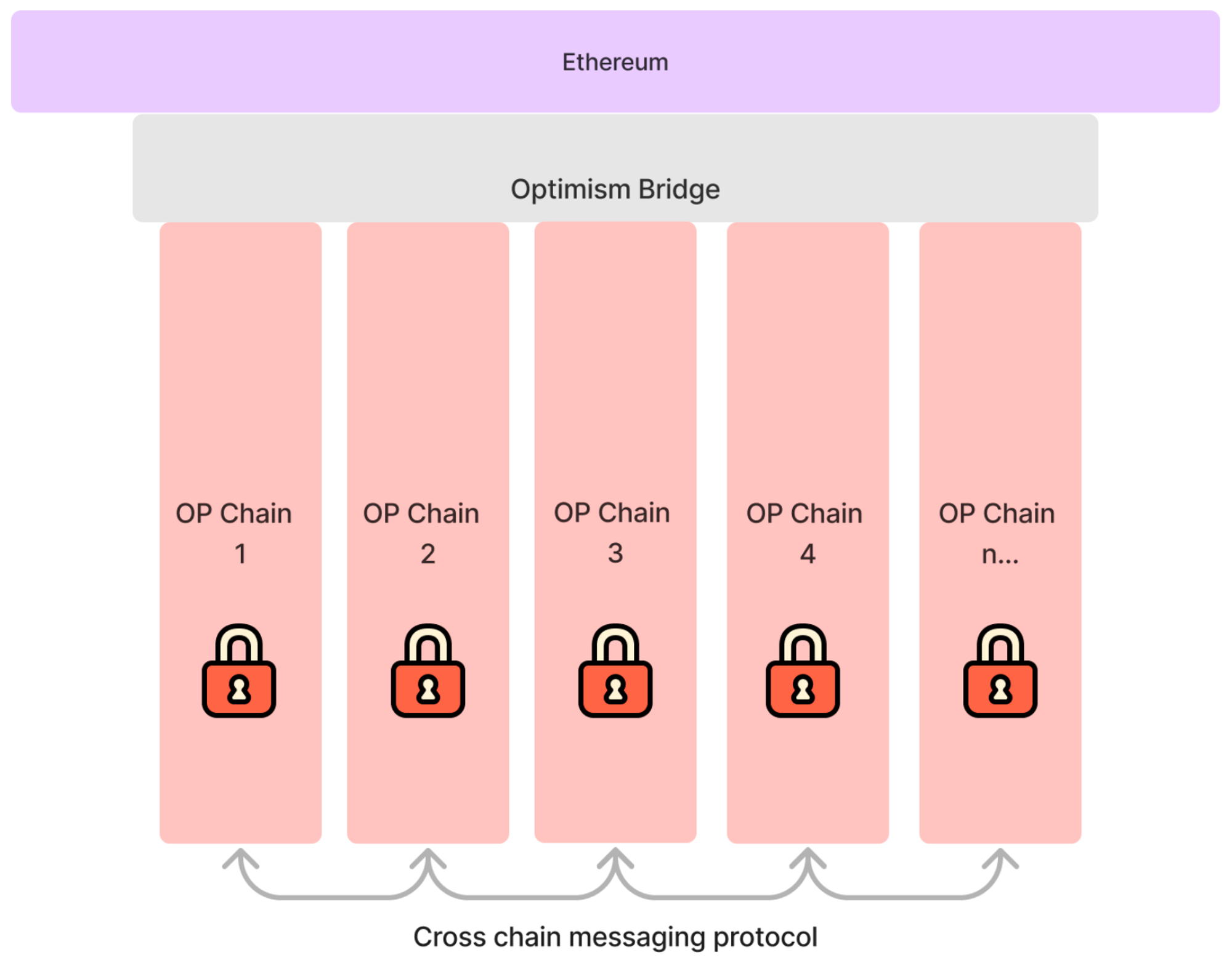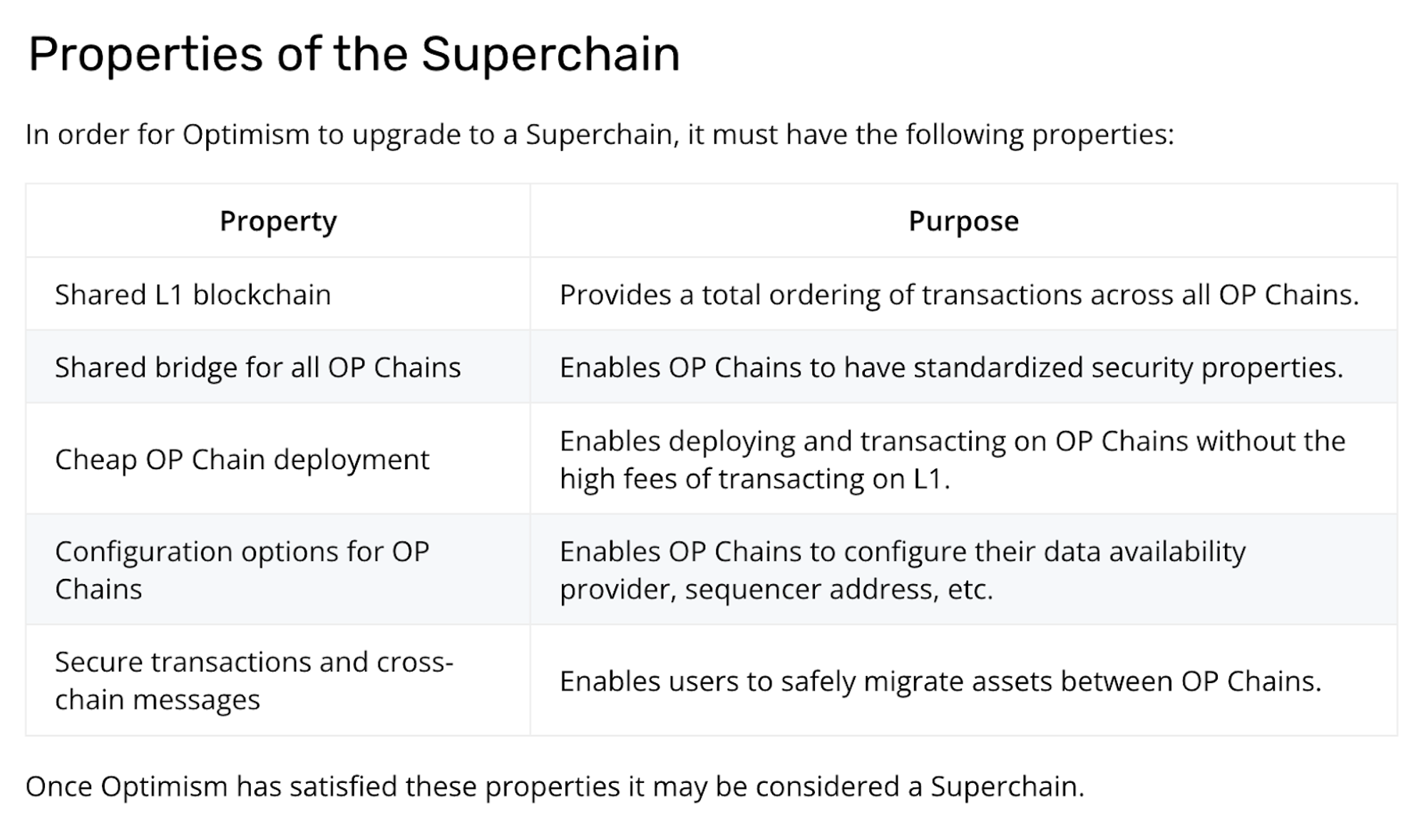What is the Superchain? The Complete Guide
The Superchain is a vision to create a unified framework for Ethereum Layer 2 networks, all built on the same open-source tech stack.

Ethereum's scalability challenges hinder web3's mass adoption. As various teams seek solutions, layer 2 (L2) networks, particularly Optimism, emerged as one of the leading solutions.
Optimism is based on optimistic rollups that employ off-chain computation and batched on-chain validation. To scale Ethereum, Optimism is taking a unique path of establishing a standard to unify networks. Their first effort is the OP Stack — an open-source toolkit to build optimistic rollups-based L2s on Ethereum — introduced in the Bedrock upgrade.
OP Stack is the launchpad to their ultimate Ethereum scaling solution — The Optimism Superchain. A hub for all L2s built using OP stack to interact and transact with one another.
Optimism is championing interoperability in a space generally dominated by siloed efforts.
Now, what is the Superchain actually and why is it important? How does it work? And how do you build on it?
In this blog post, we will explain what a Superchain is, how it works, its use cases, and live projects built on Superchain.
What is Optimism Superchain?
The Superchain, as coined by Optimism, is a network of Layer 2 blockchain networks sharing a common development stack (the open-source OP Stack), bridging, communication layer, and security. It ensures that individual chains can cohesively communicate and function as a singular unit.
Essentially, Superchain facilitates horizontal scaling.
Rather than creating entirely new, isolated blockchains or chains, the Superchain allows for the construction of interconnected Layer 2 rollup networks. Each of these networks or ‘OP chains’ share a common foundational layer i.e. the OP Stack. The standardized architecture ensures they can communicate seamlessly with one another.
Advantages of Superchain
- Interconnected efficiency: Facilitates seamless transactions across multiple "sub-chains", multiplying the ecosystem's processing capacity.
- Consistent security: Interconnected L2 networks adhere to a consistent security protocol, maintaining trust and security uniformly across the Superchain.
- Dynamic scalability: Easily expandable as more chains can be added permissionlessly and this doesn’t pause or disrupt existing networks.
Simply put, the Superchain transforms Ethereum from a singular, often congested highway into a vast, interconnected network of superhighways. Each lane (or OP chain) can handle traffic (or transactions), and vehicles (or data) can easily switch between them as needed, dramatically improving Ethereum's scalability and potential for mass adoption.
How does the Superchain work?
Before we dive into how the Superchain works, we need to know the ABCs of the OP stack which acts as the backbone for all the networks that make up the Superchain.
OP Stack
The OP Stack provides a structured approach to blockchain systems. The structure can be broken down into five distinct layers, each of which has its specific purpose and functionality:
- Data availability layer dictates where raw inputs for an OP Stack-based chain are sourced primarily through Ethereum DA.
- Sequencing layer controls how user transactions are collected and relayed, typically managed by a single sequencer.
- Derivation layer processes raw data into inputs for the execution layer, primarily using rollups.
- Execution layer defines the system state structure and transition functions. Ethereum virtual machine (EVM) is the central module.
- Settlement layer allows external blockchains to view an OP Stack chain's valid state with the attestation-based fault proof.

Law of chains
As numerous OP Stack chains emerge, a unified approach becomes crucial to maintain Ethereum's core values of decentralization and openness. The ‘Law of Chains’ is a foundational framework designed for the Superchain.
The Law of Chains is not legally binding, but it is a social contract, emphasizing community collaboration, neutrality, and shared growth. It has three major functions:
Stakeholder recognition: The Law identifies Superchain's key players: chain governors, services, and users.
Rights and protections: It offers a framework safeguarding stakeholders' interests ensuring that the decisions think about everyone's rights and effects.
Balancing unity and independence: The Law lets chains join a bigger system while keeping their own economic and social freedom, balancing global rules with individual chain autonomy.
Bedrock upgrade
Recently, the OP Stack received the Bedrock upgrade, designed to be modular, upgradeable, and nearly 100% Ethereum-equivalent, by reusing Ethereum code.
This was a significant move as this is a pre-requisite for the creation of the initial Superchain. Here are some improvements added by the Bedrock upgrade to the OP Stack:
- Reduced transaction fees: Bedrock employs optimized batch compression to substantially reduce transaction fees. It also eliminates all EVM-related gas costs during L1 data submission cutting down fees further.
- Faster deposit confirmations: Bedrock's support for L1 re-org in its node software expedites deposit confirmations. Where earlier versions took up to 10 minutes, Bedrock aims to achieve this within 3 minutes.
- Enhanced proof modularity: Bedrock adds proof modularity by permitting the use of either fault or validity proofs. This modular approach enables the integration of systems like Cannon for fault verification.
- Boosted node performance: Bedrock permits the execution of several transactions within a single rollup block. The update also eradicates previous versions' technical debt by removing the separate "data transport layer" node.
- Greater Ethereum equivalence: Bedrock ensures that the OP Stack design closely mirrors Ethereum, eliminating prior deviations like custom opcodes and unique ERC20 representations for ETH balances. Bedrock also adds support for EIP-1559 and other key Ethereum features present on L1.
Apart from Bedrock, below are the prerequisites needed for Optimism to upgrade into a Superchain.

What projects are built on the Superchain (OP Stack)?
There are several projects already built and working on the Superchain. We will divide them into three parts:
Chain platforms
- Conduit: Conduit offers ‘rollup as a service’ using the OP Stack on Ethereum. They build production-ready rollups with feature tools like faucets, DDOS protection, and block explorers. Each rollup built using Conduit is, by default, a part of the Superchain ecosystem.
- Caldera: Caldera makes it easy to launch OP Stack-based rollups. They build L2 rollups, customized for decentralized applications — offering high throughput, low latency, and rapid confirmations.
Chains
- OP Mainnet: OP Mainnet, developed by OP Labs, is an EVM-compatible Ethereum L2 solution. Utilizing optimistic rollups, it efficiently processes transactions off-chain while maintaining verifiable on-chain proofs. This seamless integration accelerates Ethereum transactions without compromising their validity.
- Base: The base is an Ethereum L2 built and maintained by Coinbase. It is built on the open-source OP Stack and champions the permissionless and decentralized vision of the Superchain. It provides cost-effective EVM compatibility for developers and offers account abstraction use cases like gasless dapp transactions through user-friendly APIs.
- opBNB: opBNB is an L2 solution built on the Optimism OP Stack, tailored to the BNB Smart Chain (BSC). Adopting the Optimistic rollup architecture, opBNB processes transactions off-chain, enhancing transaction speed and reducing gas fees. OpBNB, utilizing the OP Stack, boasts inherent modularity i.e. the ability to work harmoniously with other chains of the Superchain.
Applications
- Farcaster: Farcaster is a decentralized protocol for creating social apps, allowing users to control their data while enabling developers to build apps without restrictions. Recently, Farcaster made its significant transition to the OP Mainnet. This move pushes permissionless sign-ups to Farcaster broadening its user base. This also means Farcaster no longer depends on corporate APIs.
- Lyra Protocol: Lyra Protocol, an on-chain Options DEX, is evolving to v2 on the Lyra Chain, an L2 built using the OP Stack. It's set to be a foundation for DeFi derivatives, emphasizing modularity, enabling derivatives protocols atop its Risk Engine. Enhancements in v2 include gasless transactions, advanced Smart Contract Wallets, and improved key management. This modular design ensures adaptability and easy integration of new assets or features.
Having looked at a few OP Stack projects, let us delve into how to build on the Superchain.
How to build on the Superchain?
For those looking to build on the Superchain, here is a brief on how to get started:
How to build apps on the Superchain
thirdweb offers a suite of web3 development tools that are fully EVM-compatible. As a mesh of EVM chains, this means that they enable anyone to deploy smart contracts & build dApps on any Superchain network. For example:
Simply search for your chain of choice and start building:
How to build blockchain networks
The first step towards building on the Superchain is to build a blockchain network using the OP Stack by Optimism. This is a key requisite as it internalizes the communication, bridging, and shared security layers needed to be a part of the Superchain.
Platforms like Conduit and Caldera offer solutions to streamline and optimize the deployment of layer-two blockchains.
Conduit provides a "rollup as a service" platform, simplifying the creation of rollups using the OP Stack. Caldera, in contrast, focuses on crafting high-performance, customizable blockchains tailored for specific decentralized applications.
What lies ahead for the Superchain?
The Optimism Superchain marks a significant evolution in the Ethereum ecosystem, unifying a network of L2 chains for enhanced scalability and interoperability. Its modular and standardized design can cater to diverse applications, allowing seamless integration and development. This interconnectedness also fosters heightened security through shared validation processes.
Ultimately, the Superchain can be a catalyst in driving the mass adoption of blockchain technologies. Building on the Superchain can be made simpler using thirdweb’s comprehensive web3 development framework.
If you have any questions, join 40,000+ other builders in our Discord community or reach out to the team directly for more info on how to get started with OP Stack.
And if you want to start building apps on the Superchain, get started with thirdweb’s web3 tools and SDKs - they’re free!
